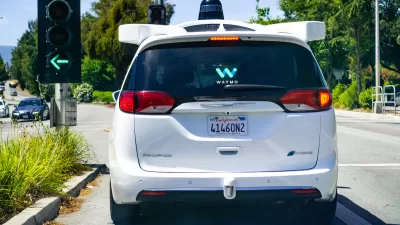If allowed to operate on the traffic-restricted street, Waymo’s autonomous taxis would have a leg up over ride-hailing competitors — and counter the city’s efforts to grow bike and pedestrian on the thoroughfare.

Waymo, the autonomous taxi operator, could soon have access to San Francisco’s Market Street, a major thoroughfare closed to most private vehicles.
As Greg Wong explains in the San Francisco Examiner, the city allowed the company to survey and map the street, paving the way for autonomous taxi service. Currently, Waymo is allowed to operate on most of the city’s streets.
“When asked by The Examiner if there was any other San Francisco street the company does not operate on, Waymo spokesperson Katherine Barna responded that The City ‘has some unique lanes of traffic that are restricted to certain types of vehicles, though none as large or notable as Market Street.’” The company would not elaborate on the exact locations of these streets.
The Better Market Street program only allowed buses, taxis, and commercial vehicles (including Waymo) to operate on the street in an effort to encourage more foot and bike traffic. Now, Mayor Lurie says Waymo will be “another safe and sustainable way” to access businesses along the corridor. “If Waymo ultimately gets city approval to offer ride-hailing services on Market Street, it would give the company an edge over competitors — namely Uber and Lyft — that can’t do the same.”
FULL STORY: Why Market Street isn't Waymo's final frontier in SF

Alabama: Trump Terminates Settlements for Black Communities Harmed By Raw Sewage
Trump deemed the landmark civil rights agreement “illegal DEI and environmental justice policy.”

Planetizen Federal Action Tracker
A weekly monitor of how Trump’s orders and actions are impacting planners and planning in America.

The 120 Year Old Tiny Home Villages That Sheltered San Francisco’s Earthquake Refugees
More than a century ago, San Francisco mobilized to house thousands of residents displaced by the 1906 earthquake. Could their strategy offer a model for the present?

Indy Neighborhood Group Builds Temporary Multi-Use Path
Community members, aided in part by funding from the city, repurposed a vehicle lane to create a protected bike and pedestrian path for the summer season.

Congestion Pricing Drops Holland Tunnel Delays by 65 Percent
New York City’s contentious tolling program has yielded improved traffic and roughly $100 million in revenue for the MTA.

In Both Crashes and Crime, Public Transportation is Far Safer than Driving
Contrary to popular assumptions, public transportation has far lower crash and crime rates than automobile travel. For safer communities, improve and encourage transit travel.
Urban Design for Planners 1: Software Tools
This six-course series explores essential urban design concepts using open source software and equips planners with the tools they need to participate fully in the urban design process.
Planning for Universal Design
Learn the tools for implementing Universal Design in planning regulations.
Clanton & Associates, Inc.
Jessamine County Fiscal Court
Institute for Housing and Urban Development Studies (IHS)
City of Grandview
Harvard GSD Executive Education
Toledo-Lucas County Plan Commissions
Salt Lake City
NYU Wagner Graduate School of Public Service





























